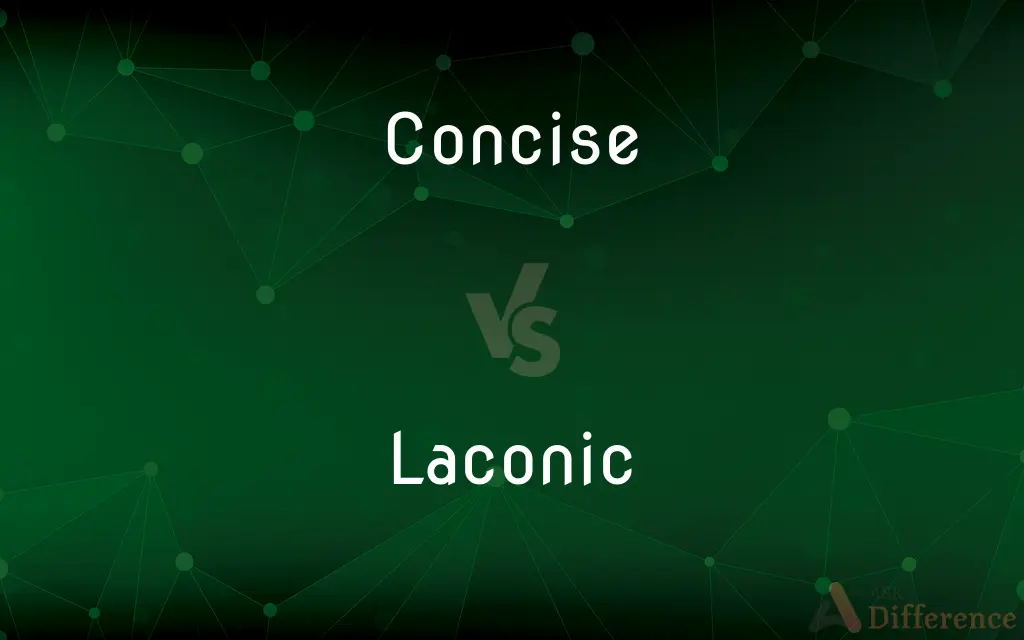Concise vs. Laconic — What's the Difference?
Edited by Tayyaba Rehman — By Fiza Rafique — Updated on May 8, 2024
"Concise" refers to expressing information clearly and efficiently without unnecessary details, while "laconic" describes a style that is terse, often to the point of seeming rude or mysterious.

Difference Between Concise and Laconic
Table of Contents
ADVERTISEMENT
Key Differences
Conciseness involves using the fewest words necessary to clearly convey an idea or information, prioritizing brevity and clarity. On the other hand, laconic speech or writing is extremely brief and can come across as terse or overly simplistic, sometimes intentionally leaving much unsaid.
While concise communication is appreciated in academic and professional settings for its efficiency and effectiveness, laconic communication may be perceived as curt or lacking in detail, suitable in contexts where minimal communication is desired.
A concise statement provides enough detail to be understood without further explanation, making it ideal for instructions or informational content. Conversely, laconic statements might require interpretation or context, as they often rely on the audience's ability to infer meaning.
The goal of being concise is to avoid redundancy and superfluous details while still being complete. In contrast, being laconic can involve cutting down so much that only the essence remains, sometimes at the expense of clarity or politeness.
In writing and speech, conciseness is often achieved through careful word choice and sentence structure, enhancing readability and understanding. Laconic speech, however, uses minimalism to such an extent that it may sacrifice these qualities for the sake of brevity.
ADVERTISEMENT
Comparison Chart
Definition
Expressing much in few words clearly
Using very few words, often to the point of terseness
Perceived Tone
Efficient, clear
Curt, possibly mysterious or aloof
Common Contexts
Academic, professional, informational
Casual, dramatic, or when minimalism is required
Purpose
Eliminate redundancy, enhance clarity and understanding
Convey thoughts with minimal effort, often stylistic
Impact on Communication
Enhances readability and comprehension
May require additional context to be fully understood
Compare with Definitions
Concise
Clear and direct in communication.
His concise email outlined all the meeting points efficiently.
Laconic
Can appear aloof or mysterious.
The detective's laconic demeanor added to his intimidating presence.
Concise
Aimed at maximizing comprehension.
For clarity, please keep your arguments concise during the debate.
Laconic
Often leaves things unsaid.
His laconic comments during interviews are famously cryptic.
Concise
Expressing or covering much in few words.
The professor’s instructions were concise and easy to follow.
Laconic
Style of speaking or writing that is succinct to the point of seeming rude.
His laconic reply left us wondering if he was upset.
Concise
Avoids unnecessary details.
Her concise summary saved us a lot of reading time.
Laconic
Effective in conveying an attitude or style.
The author’s laconic writing style suited the spare landscape of his stories.
Concise
Often associated with professionalism.
The report was concise, fitting all key data onto one page.
Laconic
Uses minimalism in words.
Her laconic speech at the ceremony was unexpectedly brief.
Concise
Concise is a municipality in the district of Jura-Nord Vaudois in the canton of Vaud in Switzerland.
Laconic
(of a person, speech, or style of writing) using very few words
His laconic reply suggested a lack of interest in the topic
Concise
Giving a lot of information clearly and in a few words; brief but comprehensive
A concise account of the country's history
Laconic
Using or marked by the use of few words; terse or concise.
Concise
Expressing much in few words; clear and succinct.
Laconic
Using as few words as possible; pithy and concise.
Concise
Brief, yet including all important information
Laconic
Expressing much in few words, after the manner of the Laconians or Spartans; brief and pithy; concise; brusque; epigrammatic. In this sense laconic is the usual form.
I grow laconic even beyond laconicism; for sometimes I return only yes, or no, to questionary or petitionary epistles of half a yard long.
His sense was strong and his style laconic.
Concise
(obsolete) Physically short or truncated
Laconic
Laconian; characteristic of, or like, the Spartans; hence, stern or severe; cruel; unflinching.
His head had now felt the razor, his back the rod; all that laconical discipline pleased him well.
Concise
To make concise; to abridge or summarize.
Laconic
Laconism.
Concise
Expressing much in a few words; condensed; brief and compacted; - used of style in writing or speaking.
The concise style, which expresseth not enough, but leaves somewhat to be understood.
Where the author is . . . too brief and concise, amplify a little.
Laconic
Brief and to the point; effectively cut short;
A crisp retort
A response so curt as to be almost rude
The laconic reply; `yes'
Short and terse and easy to understand
Concise
Expressing much in few words;
A concise explanation
Common Curiosities
How can one develop a concise writing style?
To develop a concise writing style, focus on clarity, brevity, and avoiding unnecessary details.
How does one avoid being too laconic?
To avoid being too laconic, ensure that your communication still includes enough context or information for the listener to understand your intent and meaning.
Can a speech be both laconic and concise?
Yes, a speech can be both laconic and concise if it effectively conveys the necessary information in a very brief manner without omitting crucial details.
How does culture impact the perception of concise versus laconic communication?
Cultural expectations can greatly affect how concise or laconic communication is perceived; some cultures value detailed and elaborate expressions, while others prefer succinct communication.
What does it mean to be concise?
Being concise means providing necessary information in a clear and brief manner without redundancy.
Is laconic communication effective?
Laconic communication can be effective in certain contexts where brevity is valued over detail, though it may sometimes be perceived as abrupt.
Can concise communication be seen as rude?
While concise communication aims for efficiency and clarity, it is generally not perceived as rude if well-balanced and considerate.
Can laconic communication be misinterpreted?
Yes, laconic communication is prone to misinterpretation because it often relies on the audience's ability to infer or fill in the gaps, which can lead to different interpretations.
What is a laconic personality like?
A laconic personality might come across as reserved or sparse in communication, often saying little but implying more.
In what situations might a laconic response be preferable?
A laconic response might be preferable in situations where time is limited, such as during crisis management, or when communicating with someone who prefers directness.
What are the risks of overly concise communication?
Overly concise communication can risk leaving out important details, leading to misunderstandings or a lack of depth in the information presented.
What literary styles favor laconic expression?
Literary styles such as minimalism and some forms of modernism favor laconic expressions, where sparse language heightens the thematic impact.
Why is being concise important in professional communication?
Being concise in professional communication saves time, enhances clarity, and ensures that the essential messages are not lost or overlooked.
Why might someone intentionally use laconic speech?
Someone might use laconic speech to create a particular effect or persona, to control the flow of information, or to maintain an air of mystery or authority.
What are the advantages of concise writing in academic settings?
Concise writing in academic settings helps in presenting ideas clearly and directly, making arguments more compelling and easier for readers to follow.
How can teachers ensure their instructions are concise and not laconic?
Teachers can ensure their instructions are concise by being clear and brief but also by providing sufficient detail to avoid ambiguity and ensure understanding.
Share Your Discovery

Previous Comparison
Preference vs. Discount
Next Comparison
Mauritius vs. MauritaniaAuthor Spotlight
Written by
Fiza RafiqueFiza Rafique is a skilled content writer at AskDifference.com, where she meticulously refines and enhances written pieces. Drawing from her vast editorial expertise, Fiza ensures clarity, accuracy, and precision in every article. Passionate about language, she continually seeks to elevate the quality of content for readers worldwide.
Edited by
Tayyaba RehmanTayyaba Rehman is a distinguished writer, currently serving as a primary contributor to askdifference.com. As a researcher in semantics and etymology, Tayyaba's passion for the complexity of languages and their distinctions has found a perfect home on the platform. Tayyaba delves into the intricacies of language, distinguishing between commonly confused words and phrases, thereby providing clarity for readers worldwide.













































